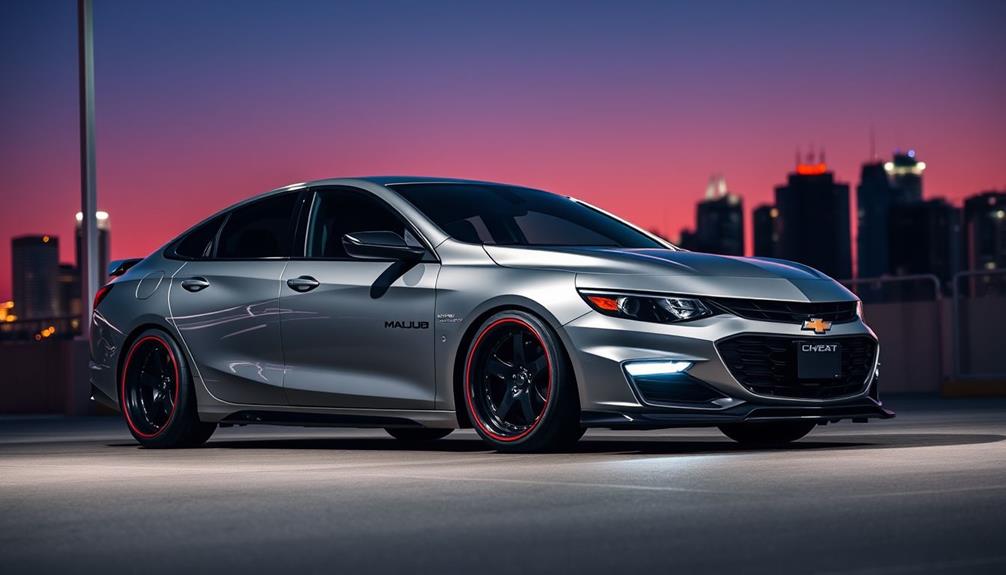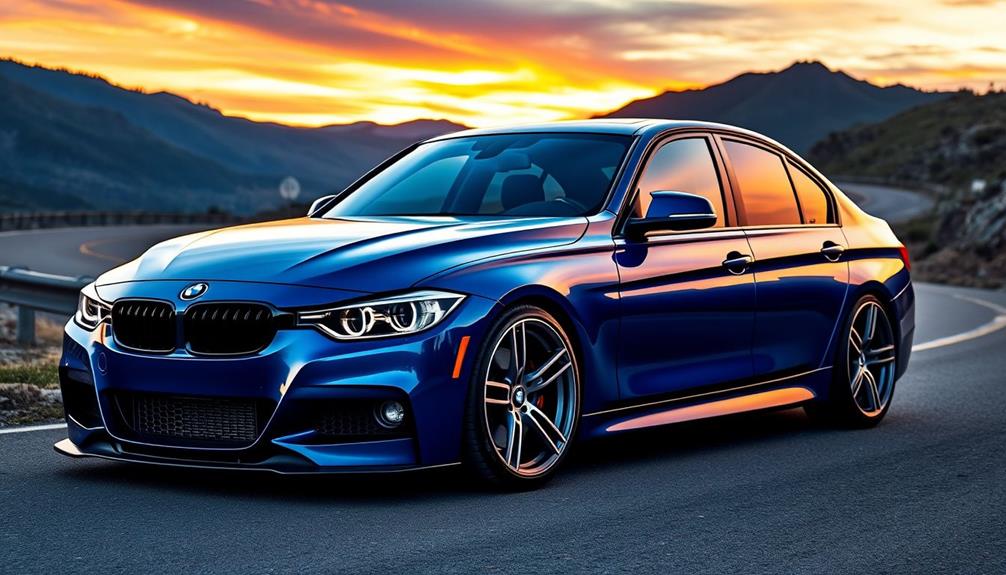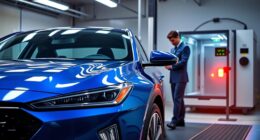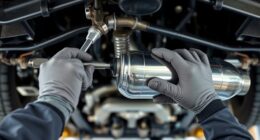Tuning your 2018 Chevrolet Malibu can truly release its hidden potential, transforming it from a dependable sedan into an exhilarating ride. By exploring options like the TRIFECTA recalibration, you can boost your engine by up to 49 horsepower and 48 lb-ft of torque. Upgrading your intake and exhaust will not only enhance performance but also add aesthetic appeal. For those seeking a major power jump, consider engine swaps or advanced tuning solutions. This thorough tuning journey guarantees you maintain fuel efficiency while enjoying improved throttle response. There's much more to discover about maximizing your Malibu's performance.
Key Takeaways
- Tuning the 2018 Malibu can achieve significant power gains, such as an additional 49 hp and 48 lb-ft of torque with TRIFECTA recalibration.
- Performance upgrades, including intake and exhaust modifications, enhance both power and visual appeal without requiring major engine swaps.
- Engine swaps provide substantial performance improvements but involve high costs and technical expertise for proper integration.
- Tuning software like TRIFECTA is user-friendly and retains GM OE diagnostics, making it accessible for first-time tuners.
- Balancing power and fuel efficiency is possible, with some drivers experiencing improved city gas mileage after tuning.
Overview of the 2018 Malibu
When you get behind the wheel of the 2018 Chevrolet Malibu, you'll immediately notice its blend of performance and efficiency. Powered by a 1.5L turbo engine, the Chevy Malibu delivers 163 horsepower and 184 lb-ft of torque, ensuring you'll enjoy a spirited drive without sacrificing fuel economy.
With an estimated 36 MPG on the highway, you can hit the open road with confidence, knowing your car is designed for both power and efficiency. The Malibu's lightweight structure and aerodynamic design play an essential role in enhancing performance while keeping fuel consumption low.
You'll appreciate the spacious interior, which is packed with modern technology, including an advanced infotainment system that supports Apple CarPlay and Android Auto.
Safety is a priority in the 2018 model, equipping you with advanced features like forward collision alert, lane keep assist, and a rear vision camera.
With various trims available, such as the LT and Premier, you can customize your Chevy Malibu to align with your driving preferences and lifestyle. This car truly offers a well-rounded driving experience, making it a standout choice in the sedan market.
Performance Modification Options

Exploring performance modification options for the 2018 Chevy Malibu can release its full potential, transforming your driving experience.
The Malibu LT's 1.5L engine already delivers a respectable 163 horsepower and 184 lb-ft of torque, but with the right tweaks, you can greatly enhance those figures.
One of the most effective modifications is engine tuning. Using options like the TRIFECTA recalibration, you could gain up to 49 additional horsepower and 48 lb-ft of torque, considerably improving acceleration and throttle response.
If you're looking for a different sound and visual appeal, consider intake and exhaust modifications, though they offer modest performance gains.
For those ready to take a bigger leap, advanced tuning solutions like the VR Tuned ECU Flash can elevate your Malibu's power to around 295 horsepower and 319 lb-ft of torque, while also refining shift responsiveness.
While engine swaps promise substantial upgrades, they come with high costs—typically $5,000 to $10,000—and require careful planning for compatibility.
Explore these performance modification options, and see how you can elevate your Chevy Malibu into a truly exhilarating ride.
Engine Swaps Explained

If you're looking to take your performance modifications a step further, engine swaps can offer a significant boost in power and capability for your 2018 Chevrolet Malibu. Swapping in a high-performance engine can transform your sedan into a thrilling machine, but it's not without its challenges.
You'll need a compatible PCM, engine, and transmission from a modern donor vehicle, which can complicate the process. The estimated costs for engine swaps range from $5,000 to $10,000, making it a considerable financial investment.
You also have to guarantee proper communication between the new engine components and your vehicle's systems. This can be tricky due to ECM locking and compatibility issues that often arise with modern vehicles like the Malibu, which aren't designed for extensive upgrades without major modifications.
Community feedback highlights a mix of excitement and skepticism about engine swaps in family sedans, emphasizing the need for technical expertise. If you're up for the challenge, an engine swap can elevate your Malibu's performance, but be prepared for the complexities involved in making it work seamlessly.
Community Insights and Opinions

While many Chevrolet Malibu 2018 owners are enthusiastic to plunge into performance tuning, opinions within the community vary considerably. Some members are excited about the potential gains, particularly with modifications like the TRIFECTA recalibration, which can boost your ride by up to +49 horsepower and +48 lb-ft torque.
Additionally, the excitement surrounding young tennis prodigies parallels the enthusiasm seen in the tuning community, as both groups are passionate about revealing potential and achieving high performance. However, others remain skeptical about the practicality of these upgrades for a family sedan, citing concerns about engine modifications due to ECM locking that limits tuning options.
You'll find plenty of discussions around the challenges of achieving significant performance upgrades without resorting to an engine swap. Despite these hurdles, many users express high levels of satisfaction with tuning products, viewing them as a worthwhile investment to enhance driving pleasure.
This is especially relevant when comparing the Malibu to sportier competitors like the Dodge Charger and Subaru WRX STI.
The community thrives on sharing personal experiences, and there's a palpable excitement for visual updates and performance comparisons post-modification. This collaborative spirit fosters an environment where you can learn from others' projects, making it easier to navigate your own journey into turbo charged performance tuning.
Historical Performance Comparisons
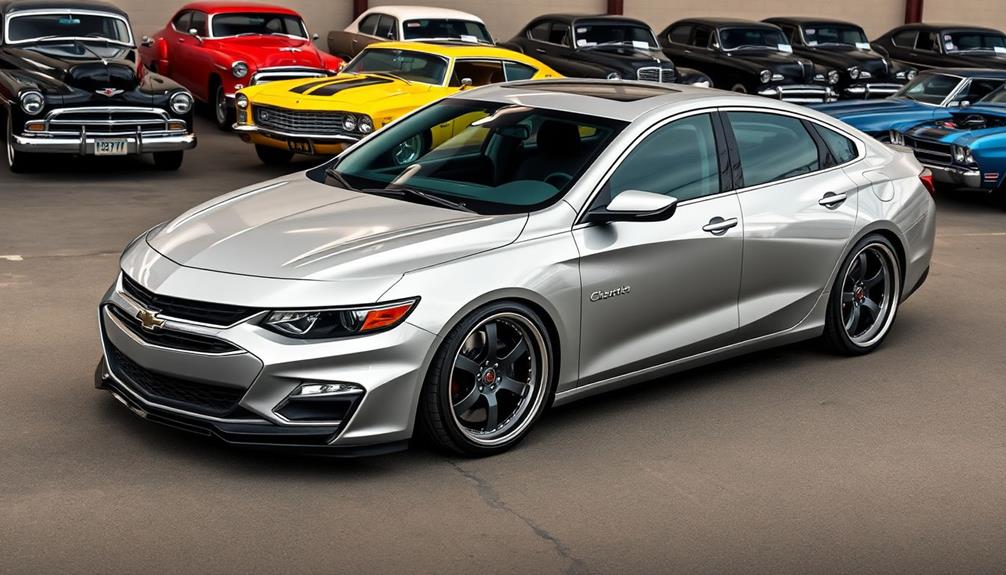
Performance tuning isn't just about the here and now; it also invites a comparison with the past. When you look at historical performance comparisons, you'll notice that modern vehicles like the 2018 Chevrolet Malibu easily outperform older muscle cars in both horsepower and fuel efficiency.
For example, a 2011 V6 engine delivers 252 hp while achieving 27 MPG on the freeway, showcasing the advancements in engine technology.
Classic muscle cars had 0-60 times ranging from 6 to 8 seconds, but today's sedans can match or even exceed that performance with smaller engine displacements. The use of lighter materials and advanced transmission systems in modern vehicles allows for improved acceleration and handling, making them more agile on the road.
The evolution of automotive technology over the decades has dramatically transformed performance metrics. With the right tuning, the Malibu can tap into its potential, proving that it's not just a modern sedan but a competitive alternative to traditional muscle cars.
Tuning Software and Features
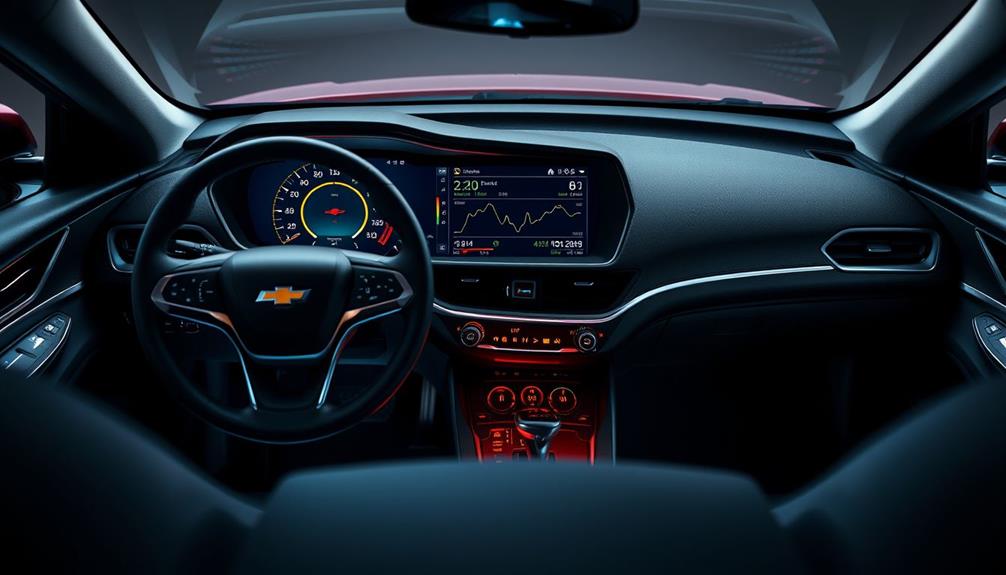
Tuning software is a game changer for enhancing your 2018 Chevrolet Malibu's performance. With options like TRIFECTA, you can gain access to an impressive boost of up to +49 horsepower and +48 ft-lbs of torque. This significant recalibration transforms your driving experience, making your Malibu not just a sedan but a performance machine.
HP Tuners offers another powerful platform that allows you to log real-time data, helping you customize various performance parameters specific to your Malibu model. Whether you're an experienced tuner or a novice, the user-friendly TRIFECTA tune installation process averages just 15-20 minutes, making it accessible for everyone.
What's even better is that this tuning software retains all GM OE diagnostics, ensuring your vehicle stays compliant with emissions readiness checks while delivering enhanced performance.
Plus, regular updates and dedicated support from the tuning software community help you maintain peak performance and tackle common tuning issues.
Investing in tuning software for your Chevrolet Malibu not only elevates its power but also gives you the freedom to tailor your ride to suit your driving style.
Installation Experience and Tips
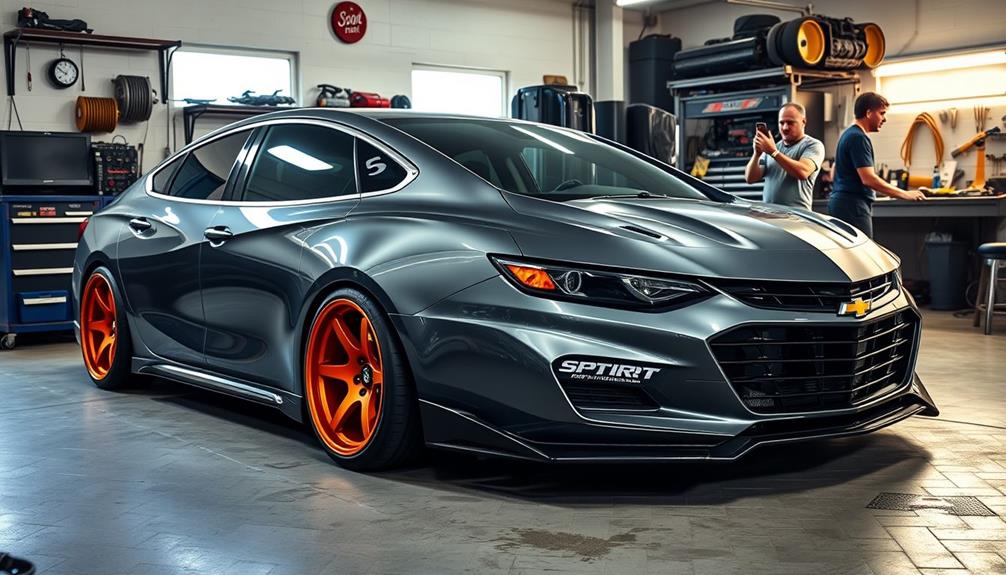
When installing the TRIFECTA tune on your 2018 Chevrolet Malibu, you'll find the process straightforward and quick, taking only about 15-20 minutes.
You won't need any technical expertise; it's designed to be user-friendly, making it accessible for novices and first-time tuners. Just a simple software download and cable connection are all you need.
Here are some tips to enhance your installation experience:
- Utilize customer support: They're available for quick solutions to any inquiries or troubleshooting needs.
- Check your connections: Confirm everything's plugged in properly to avoid hiccups during installation.
- Reset to factory settings: If you're unsure, you can always revert your vehicle back, giving you peace of mind.
- Enjoy improved throttle response: The TRIFECTA tune enhances your driving experience while keeping all GM OE diagnostics intact.
Balancing Fuel Efficiency and Power

Finding the right balance between fuel efficiency and power is essential for optimizing your driving experience in the 2018 Chevrolet Malibu. Tuning your Malibu can lead to impressive power gains, with options like TRIFECTA recalibration offering up to 49 horsepower and 48 ft-lbs of torque.
This enhancement notably improves your throttle response and acceleration, making your drives more engaging without heavily compromising fuel economy.
While it's true that some tuning methods may slightly reduce your highway gas mileage—especially when using premium fuel—many drivers report improved city fuel economy after tuning. It's all about finding the right setup that matches your driving conditions.
By choosing the right performance upgrades, like ECU tuning, you can retain all GM OE diagnostics and functionality, ensuring emissions compliance while boosting overall performance.
Ultimately, balancing performance and efficiency means understanding how your specific tuning choices affect your vehicle. You can experience satisfying power boosts while maintaining reasonable fuel economy, allowing you to enjoy the best of both worlds in your Chevrolet Malibu.
Future Tuning Projects and Trends

As car enthusiasts look to the future, exciting tuning projects for the 2018 Chevrolet Malibu are on the horizon. With a focus on maximizing performance while maintaining efficiency, you can expect innovative solutions that cater to a range of driving preferences.
- Software Recalibration: Tools like TRIFECTA tuning can help you gain horsepower, with reports showing improvements of up to +49 horsepower and +48 lb-ft torque.
- DIY Tuning Solutions: The rise of HP Tuners allows you to customize engine parameters, making it easier for you to tackle your own performance upgrades.
- Engine Swaps: Although complex and costly, engine swaps are gaining traction among enthusiasts looking for significant performance boosts beyond traditional tuning methods.
- Aftermarket Innovations: Anticipate new products like performance air intakes and ECU flash options to enhance your Malibu's capabilities.
These trends reflect a growing interest in balancing turbo performance and fuel efficiency.
As you explore these future tuning projects, you'll not only enhance your driving experience but also engage with a community that shares your passion for performance upgrades.
Frequently Asked Questions
What Is the Common Problem With a 2018 Chevy Malibu?
The common problem with the 2018 Chevy Malibu is the ECM locking, limiting your tuning options. Many owners find that modifications lead to noise without notable performance improvements, often resulting in frustrating fault codes and compatibility issues.
What Is the Most Common Problem With Chevy Malibu?
You might think every car's perfect, but the Chevy Malibu often struggles with engine stalling. Many owners report issues like rough shifting, electrical malfunctions, and premature brake wear, impacting your overall driving experience considerably.
How Do You Reprogram a 2018 Chevy Malibu Key?
To reprogram your 2018 Chevy Malibu key, insert the original key, turn it to "On" until the security light turns off, then switch to the new key within 10 seconds. Verify it's cut correctly.
Why Does My 2018 Malibu Says Engine Power Reduced?
If your 2018 Malibu shows "engine power reduced," it usually means there's a problem with the throttle control system. Check for throttle body issues or a faulty accelerator pedal sensor, and consider using an OBD2 scanner for diagnostics.
Conclusion
Tuning your 2018 Chevrolet Malibu is like revealing a treasure chest, revealing hidden gems of performance and efficiency. By exploring modifications and diving into community insights, you're not just enhancing your ride; you're transforming it into a personalized expression of your driving spirit. As you commence on this journey, remember that the road ahead is paved with possibilities, blending power and fuel efficiency like a perfect harmony. Embrace the adventure and watch your Malibu shine brighter than ever.
